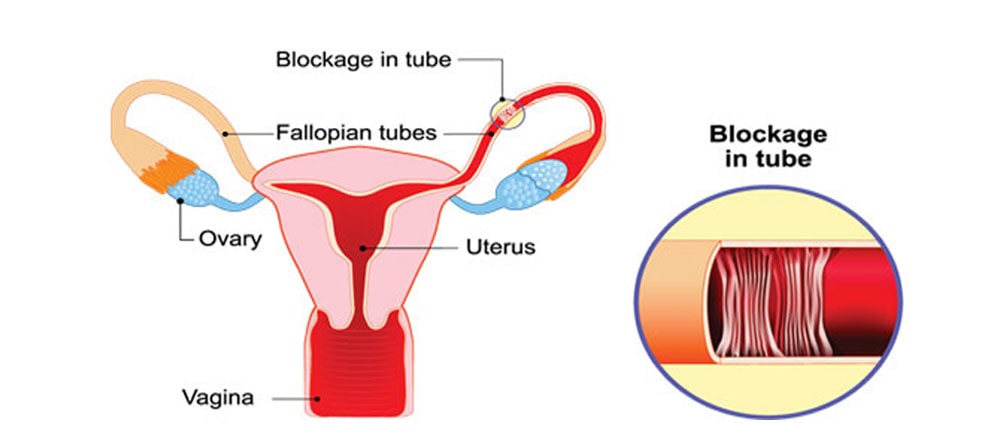
Fallopian Tubal Blockage
What Is the Function of the Fallopian Tubes
Before understanding the function lets first know what is fallopian tube.
What Is Fallopian Tube?
In Ayurveda the fallopian tube comes under artavaha srotas. The artavaha srotas covers the whole female reproductive tract and includes the structural and functional unit from the hypothalamus to the uterus. Fallopian tube in Ayurveda is called artava bija vaha srotas as it carries bija rupi artava.
Fallopian tube is a part of female reproductive system. It is a ‘J’ shaped muscular tubes also known as uterine tubes or oviducts or salpinx. The fallopian tubes extend laterally from the uterus that opens into the abdominal cavity near the ovaries.
Functions of Fallopian Tubes
The fallopian tubes act as a pathway for the passage of the ovum from the ovary to the uterus. The oviducts help in the movement of female gamete. The anatomical structure of the inner part of the tubes helps the ovum to float towards the uterus and supplies it with nutrients.
Symptoms of Blocked Tubes
Symptom of the fallopian tube blockage is not mentioned in the ayurvedic ancient texts, as tubal blockage term is not used in Ayurveda. However the clinical features can be understood by considering all the gynecological disorders. Infertility (bandhyatva) is the chief complain and through investigation tubal blockage is diagnosed. Bandhyatva is the main symptom of tubal blockage.
Usually the symptoms of blockage of fallopian tubes is not known until the women faces problems in getting pregnant. In certain cases the blocked tubes may cause mild and continuous pain on one side of the abdomen.
Hydrosalpinx is a kind of blocked fallopian. The tube blockage symptoms in this include low abdominal pain and vaginal discharge. The symptoms may not be experienced by all women.
Causes of Fallopian Tube Blockage
Fallopian tube blockage causes infertility in a woman. In Ayurveda the causes of blockage is accumulation and vitiation of doshas.
Vata dosha is responsible for any movement in the body channels. Due to the accumulation of the toxins there is dryness and narrowness of the channels that blocks the free movement of vata dosha. It can be sclerosis of the tubes or abnormal function of the tubes causing the tubal blockage.
Pitta dosha is the other important cause of the blocked tubes. The main function of pitta is digestion and metabolism. The imbalance in pitta dosha causes inflammation and certain infection in the tubes thus resulting in blockage.
Excessive accumulation of the pus in the tubes causing the obstruction is due to vitiated kapha dosha.
Apart from the doshas, dietary factors such as light food, bitter, pungent, sour, salty, hot, not easily digestible foods, sweet, abhishyandi etc causes tubal blockage.
Life style that includes excessive sexual intercourse, fasting, excessive workout, trauma, injury, sedentary lifestyle, sleeping in day time, improper vamana, anger, suppression of natural urges etc leads to fallopian tubes blockage.
The causes of bilateral tubal blockage includes–
Abortion
Miscarriage
Abdominal surgery
Ectopic pregnancy
Ruptured appendix
Uterine infection
Pelvic inflammatory disease
Any previous infection such as chlamydia
Any surgery in or near the uterine tubes.
Fallopian Tube Blockage Test
Blocked fallopian tube is not easy to identify. There are 3 main tests to check fallopian tube blockage.
1) An x-ray known as hysterosalpingogram or HSG test is done where a dye is injected into the womb that flows in the fallopian tubes and drains in the abdominal cavity in the case of unblocked tubes. If the fluid is not seen flowing into the fallopian tubes, it signifies tubal blockage.
There are certain reports where the HSG improved the pregnancy rates in certain patients. Performing HSG without imaging is called tubal flushing which improves the chances of pregnancy after HSG test blocked tubes.
2) Sonohysterogram is an ultrasound very similar to HSG test. It uses the sound waves to get the picture of fallopian tubes.
3) Laparoscopy, performed by the surgeon is done to picture the fallopian tubes from inside. It is considered the most accurate test for the blocked tubes.
Types of Fallopian Tube Blockage
Blocked fallopian tube is a common cause of female infertility. Blocked fallopian tube is also called tubal occlusion and is of the following types-
1) Hydrosalpinx
The blockage of the fallopian tubes at the end point where the tubes meet the ovary is called hydrosalpinx. If the blockage of the same kind is on both the tubes it becomes nearly impossible to get pregnant without any medical intervention.
2) Proximal tubal blockage
The blockage of the tubes at the point where it connects to the uterus is called proximal tubal occlusion. It may arise due to fibroids, endometriosis, scarring or inflammation.
3) Salpingitis isthmica nodosa (SIN)
It is a type of proximal tubal disease that is difficult to treat.
4) Tubal ligation
Due to the prior sterilization procedure the patient has 2 choices i.e tubal ligation reversal or IVF.
Fallopian tube Blockage Treatment
Fallopian tube blockage treatment without surgery
Fallopian tube blockage treatment in ayurveda
Fallopian tube blockage treatment
Ayurvedic treatment for Fallopian tube blockage treatment
Fimbrial block treatment
Unblock fallopian tube naturally without surgery
Unblock fallopian tube without surgery
Tubal blockage is one of the most critical factor for female infertility. Sometimes it becomes tough for the couples to make a baby. Ayurveda is a time tested for blocked fallopian tube treatment. Ayurvedic treatment for blocked fallopian tube is successful in curing infertility in women.
Some of the methods used by ayurvedic doctors to unblock fallopian tube naturally without surgery are balancing the doshas, dietary management, ayurvedic herbs, panchakarma therapies and improving the lifestyle.
Tubal blockage is vata-kapha dominated condition. All the three doshas are collectively responsible the tubal blockage. Infertility is mainly vatic disorder hence basti karma with snehana (oleation) and tarpana (nourishment of endometrium) is the treatment of choice to unblock fallopian tubes without surgery.
Uttara basti is the administration of medicated oil or herbal decoction through urethral or genital route in females. The drugs used are yava kshara taila, kumara taila, narayana taila, panchtika ghrita wuth nimbu taila, shatavari ghrita,mahanarayana taila, tila taila, lashuna taila etc are used for fallopian tube blockage treatment in Ayurveda.
Uttara basti is the best local treatment for tubal blockage. It cures all sort of infertility problems and all reproductive disorders as well. Uttara basti is the only option for fallopian tube blockage treatment without surgery. The treatment must be undertaken by the qualified and highly experienced ayurvedic doctor as it requires proper selection of drugs and proper time of administration for best results.
Both Fallopian Tube Blockage Treatment
It is impossible to get pregnant when both the tubes are completely blocked. Whether you need left or right tube blocked treatment, both or one blocked fallopian tube treatment, the best choice is Ayurveda for blocked fallopian tube treatment.
In hydrosalpinx the fluid that normally flows through the tube is trapped due to the blockage that may result the tube to swell. The hydrosalpinx treatment in Ayurveda is same as mentioned earlier.
Natural Treatment for Blocked Fallopian Tubes
If you are diagnosed with blocked fallopian tubes follow the following remedies that might help to unblock the tubes naturally.
1) Say no to smoking and alcohol– alcohol and tobacco have proved to have a negative effect on women fertility.
2) Consume vitamin C rich diet– it boosts immunity and enhances the absorption of iron. Tubal blockage due to infection can be healed with this.
3) Meditation– stress is the major cause of infertility in women hence meditation helps to de stress.
4) Antioxidant rich diet– such diet fights the negative effects of junk food.
5) Panchakarma– go for panchakarma therapy as it eliminates all the toxic substance out of the body and helps the body to absorb nutrients thus improving the overall health.
6) Marma therapy– it is acupressure where pressure is applied on certain pressure points in the body. It clears the blockage of energy flow in the body.
7) Exercise and stretching– it improves the blood circulation. Regular stretching exercise unblocks inflamed or injured fallopian tubes.
8) Massage – fertility massage improves blood flow, heals the tissues faster and reduces inflammation. It works good for blocked fallopian tubes.
9) Yoga – certain yoga poses such as viparita karani, setu bandhasana unblocks the fallopian tubes naturally.
10) Increase the consumption of garlic, ginger, cinnamon and turmeric.
Rescent Posts
Fallopian Tube Blockage Clinic in Mumbai, Maharashtra
Tube Blockage Clinic in Mumbai The fallopian tube connects the…
7 Steps to Getting Pregnant with Blocked Fallopian Tubes
7 Steps to Getting Pregnant with Blocked Fallopian Tubes The…
IVF Failure Treatment: Hope In Ayurveda! – By Dr Chanchal Sharma
IVF Failure: Hope In Ayurveda! – By Dr Chanchal Sharma…
Frequently Asked Questions
- An x-ray known as hysterosalpingogram or HSG test is done where a dye is injected into the womb that flows in the fallopian tubes and drains in the abdominal cavity in the case of unblocked tubes. If the fluid is not seen flowing into the fallopian tubes, it signifies tubal blockage. There are certain reports where the HSG improved the pregnancy rates in certain patients. Performing HSG without imaging is called tubal flushing which improves the chances of pregnancy after HSG test blocked tubes.
2. Sonohysterogram is an ultrasound very similar to HSG test. It uses the sound waves to get the picture of fallopian tubes.
3. Laparoscopy, performed by the surgeon is done to picture the fallopian tubes from inside. It is considered the most accurate test for the blocked tubes.
Fallopian tube blockage causes infertility in a woman. In Ayurveda the causes of blockage is accumulation and vitiation of doshas. Vata dosha is responsible for any movement in the body channels. Due to the accumulation of the toxins there is dryness and narrowness of the channels that blocks the free movement of vata dosha. It can be sclerosis of the tubes or abnormal function of the tubes causing the tubal blockage. Pitta dosha is the other important cause of the blocked tubes. The main function of pitta is digestion and metabolism. The imbalance in pitta dosha causes inflammation and certain infection in the tubes thus resulting in blockage. Excessive accumulation of the pus in the tubes causing the obstruction is due to vitiated kapha dosha. Apart from the doshas, dietary factors such as light food, bitter, pungent, sour, salty, hot, not easily digestible foods, sweet, abhishyandi etc causes tubal blockage. Life style that includes excessive sexual intercourse, fasting, excessive workout, trauma, injury, s
HSG test may cost you between 2000 to 3000 INR. It ,ay differ from lab to lab.
The drugs used are yava kshara taila, kumara taila, narayana taila, panchtika ghrita wuth nimbu taila, shatavari ghrita,mahanarayana taila, tila taila, lashuna taila etc are used for fallopian tube blockage treatment in Ayurveda.
Uttara basti is the administration of medicated oil or herbal decoction through urethral or genital route in females. The drugs used are yava kshara taila, kumara taila, narayana taila, panchtika ghrita wuth nimbu taila, shatavari ghrita,mahanarayana taila, tila taila, lashuna taila etc are used for fallopian tube blockage treatment in Ayurveda





